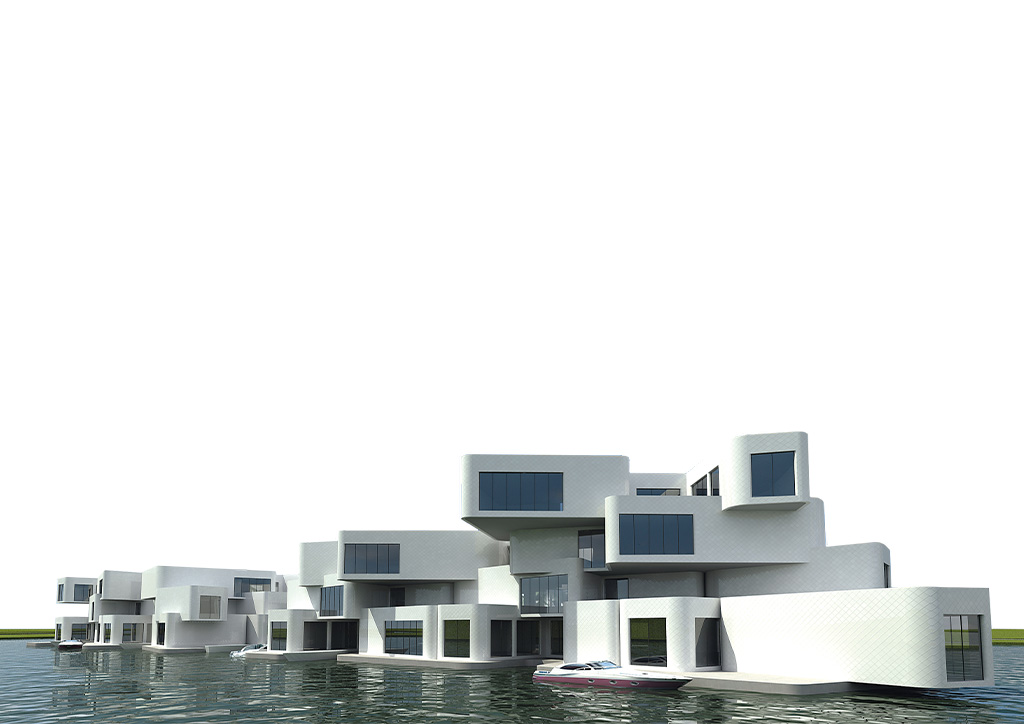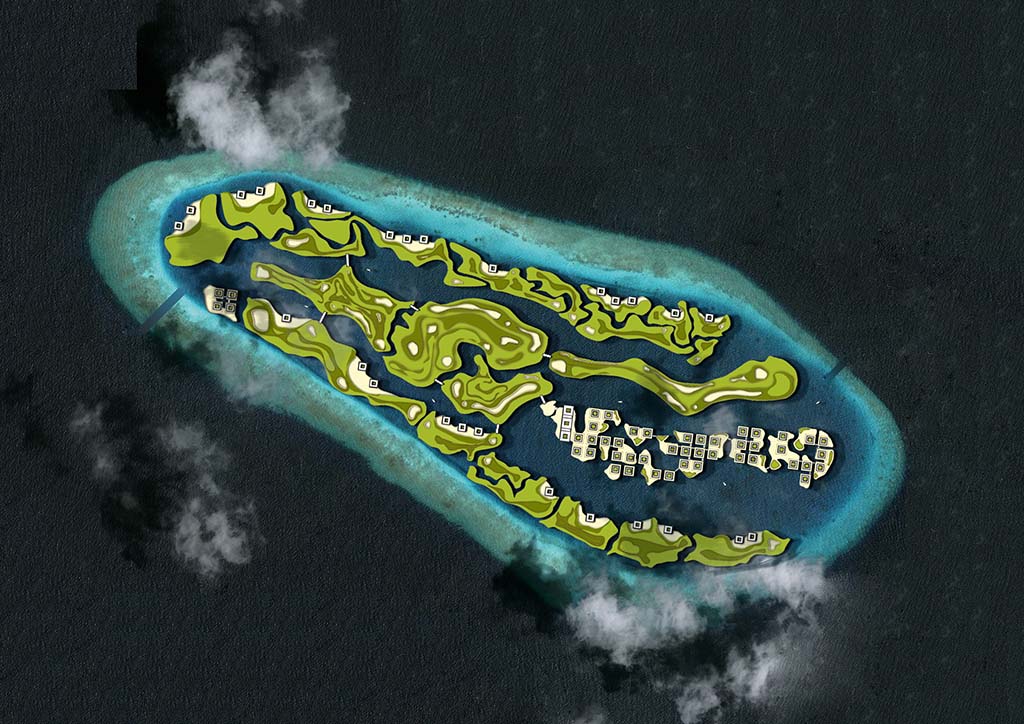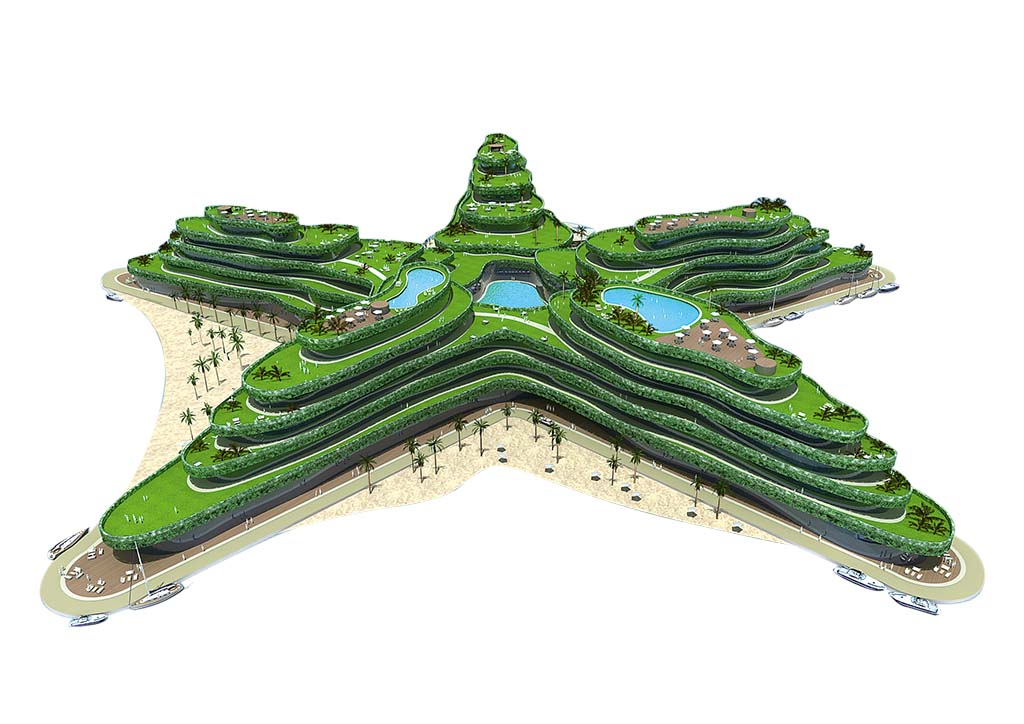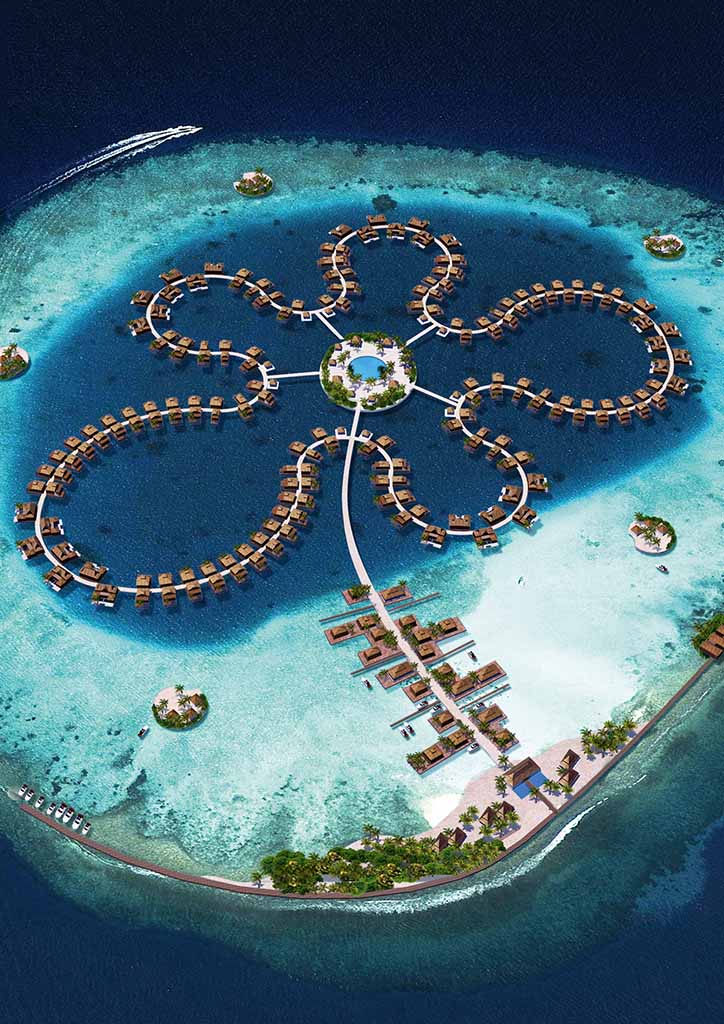
Water architecture guru Koen Olthius and his ‘Top Ten Trends Towards Floating Cities’
Ranked 122nd in a 2007 TIME magazine readers’ poll on “The Most Influential People of the Year,” and included by French magazine Terra Eco in its 2011 list of “100 Green Persons That Will Change the World,” Koen Olthuis advocates the use of floating structures as a means to address different needs of cities.
After viewing his presentation on the Internet through TED Talks, ICONs, an events organizing group of local architects, invited Dutch architect Koen Olthuis to Manila to share his vision of the future of urban development. Billed Living in Water, the organizers promoted the talk at SMX Convention Center in April 2014 as a must-attend event (“It’s not just another seminar!”) for architects, planners and concerned citizens. The event Facebook page announced, “You’d want to know: Floods, storm surges, the La Niña and the El Niño phenomena: What course of action can we take in the light of global change.” It added: “Koen Olthuis could very well be a ROCK STAR of the Architecture world—wouldn’t you want to meet and learn from him?”
Some 200 of us showed up for Olthuis’ exposition where he introduced the concept of FLOAT—Flexible Land On Aquatic Territory—essentially, building developments on water.

Floating structures, Olthuis says, enables cities to quickly develop new urban components and have them placed or relocated as the city’s needs change. He cited the Burning Man festival in Nevada in 2012 as an example of how a ‘city’ can be readily created with support systems such as police, fire fighting and medical capabilities, and easily dismantled.
He likens the adaptability of FLOAT to that of smartphone apps. Asks Olthuis: “Why can’t a city be like a phone app,” where apps can be readily installed or added for specific functions, and deleted when no longer needed? In a concept he calls “City Apps,” a floating segment with specific functions for a particular coastal city may be readily added or connected to the land-based side of the city. When that segment is no longer responsive to the needs of the city, it may be relocated to an area that needs it. Says Olthuis: “It’s all about changing perception. Floating cities don’t work any different to cities of today.” He adds: “Living on water is no different from living on land, just a different foundation technique.”
YOU MIGHT LIKE: Paulo Alcazaren elaborates on comprehensive planning lessons from Boracay
Olthuis should know. A native of the Netherlands, a country where 20% of its land is below sea level, he has centuries of land reclamation and flood control tradition in his blood. Before establishing Waterstudio.NL, “the only firm in the world exclusively dedicated to living on water,”he spent two years building traditional houseboats, and owns patents on the “method for producing a floating base.”
In his presentation, Olthuis shared what he called, “Top 10 Trends Towards Floating Cities.” All are imaginative applications, but not for wholesale adoption in the Philippine context. After the description of each “trend” we discuss its adaptability to the Philippine setting.

Top 10 Trends Towards Floating Cities
10/ Safety from floods and hurricanes
Land-based structures are much more prone to damage from storm surges, floods, typhoons and hurricanes than floating structures, which Olthuis says “will rise with the waters, and even during a tsunami event just ride the wave. In hurricane events, floating structures when sucked upwards will bob loosely on water since its foundation is not fixed to the ground.”
For structures that are land-based and provided with alternative floating bases, resiliency to flooding makes sense. The question, however, would be its effectiveness against storm surges. Typhoon Yolanda’s winds created storm surges seven meters or two storeys high. The floating structure may bob or sway with the waves, but how would this affect its occupants? At the very least, laboratory and computer model testing should be conducted to determine how such floating structures will behave during extreme weather conditions.
READ MORE: Does Manila really need another reclamation?
9/ Sustainability by using water
Waterstudio.NL designed a mosque in Dubai incorporating several transparent columns, allowing the introduction of sea water to run through the columns, cooling the interiors and saving on cooling cost. Solar panels provide additional renewable energy to run the pumps.
Waterstudio.NL’s use of water as a cooling device is similar to that of the deepwater cooling systems in Halifax, Toronto, and Ontario, which all have large sources of cold water. These deepwater cooling projects which were constructed in the early 2000s, demonstrated energy savings of up to 90% versus conventional airconditioning. The downside: high start-up cost and long payback time. The cooling system that uses seawater is particularly expensive and high maintenance because of saltwater’s corrosive effect on the metals used to conduct the water. The transparent material Olthuis used for the Dubai mosque cooling columns may not corrode as fast, but wouldn’t be an effective conductor of heat, making his system less efficient. Another concern to watch out for: “heat pollution.” Increases in temperature in the cold water source could adversely affect the aquatic environment.
YOU MIGHT LIKE: The geography of risk and resilience in Guiuan, the first town hit by Haiyan
8/ Scarless development
The tiny—and sinking—country of Maldives, so as not to take up any more precious land area, commissioned Waterstudio.NL to create a floating resort. Olthuis went further by proposing as well a floating golf course where each hole is an ‘island’ connected by an underwater tube.
Such floating amenities are very much a necessity for the shrinking Maldives (scientists say that due to rising sea levels, up to 80% of the country will be submerged towards the end of this century). However, Olthuis also pushes for the adoption of such floating facilities elsewhere, saying, “Land-based structures permanently scar the surface they are built on. Removal of these structures will not bring the land to its former natural state. [On the other hand,] floating structures allow flexibility for future generations to undo what we have built today. The sea bed below will hardly be touched or affected by structures at the surface.”

The proposal that floating islands constitute scarless development should be challenged by stringent study. Will there truly be no scars? Or will the scars simply be out of sight? Given our abundant shoreline, the value of such a development in the Philippines would be one of novelty, like a theme park, and its benefits must be carefully weighed against the likelihood of negative impact on the ecosystem and the sea bed below.
7/ Instant green solutions
Floating parks called “sea trees” for plants and animals only is one answer to the dwindling open space and greenery of cities. Here, Olthuis borrows from the floating storage containers of offshore oil rigs to create “vertical hangouts for wildlife” that may be assembled in rivers, seas, lakes and harbors. Waterstudio.NL says: “The height and depth of each sea tree can be adjusted depending on the location. The sea tree moves a bit along with the wind and is moored to the sea bed with a cable system.”
READ MORE: Manila Zoo, Pasig River, and 23 more PH places re-envisioned
The cost for each sea tree? Around one million euro or USD 1.34 million. Olthuis’ firm is currently marketing the concept to oil companies to donate sea trees to coastal cities to “show their concern for a better city environment.” The cost of a sea tree is just a tiny fraction of the cost exacted on the environment by oil extraction and oil spills, so this sounds just like the kind of public relations campaign some oil companies would go for.
The suggestion to moor these giant structures in our waters to make up for the lack of greenery in cities sounds like an all too desperate measure that only the most densely packed concrete jungle without hope of increasing its green footprint would consider. As for cities that can still make room for plants—horizontally and vertically— wouldn’t doing so be preferable to a million-dollar metal structure out in the water? Olthuis needs to prove that the benefits are worth the potential danger of typhoon winds and storm surges uprooting these ‘trees.’
6/ Floating private island
The rich man’s version of Richie Sowa’s private island in Mexico. Olthuis says these can be designed to have their own small beach and a large open space, which includes a hidden dock for the owner’s submarine. “At USD 12 million per island, it is clearly exclusive to the upper crest of society,” Olthuis admits.
Need we say more?
YOU MIGHT LIKE: How do we make sure Asia’s megacities are healthy cities?
5/ Plug and play
Olthuis suggests that cruise ships will no longer dominate maritime tourism and hospitality. A concept he presented for this trend is the Star Island Hotel with five arms each as large as a cruise ship, and a sixth docked arm. Envisioned to provide a totally different hotel resort experience, Olthuis says each arm may detach from the main structure, and after 7 years or so be replaced by the dock arm when time comes for it to be refurbished or totally remodelled. Operations can continue in as short as a few days to a week.
Floating spare city components may be a waste of resources and dock space if these are to be kept and stored for future replacement or refurbishing.

4/ Existing urban fabric
“Architects and urban planners often try to diffuse the border between land and water. Building extensions of the city on water allows a city to grow or shrink with a greater level of flexibility. Roads, greenery, and structures in the floating city will not be any different from the land-based portion of the city,” says Olthuis.
He suggests that floating components can be added to a city without affecting its fabric, unlike land reclamation, which alters the surrounding land and marine environments, for all intents and purposes, irreversibly. The adaptability issue here is the same as that of Trend #10: How will the floating structures attached to the coastline behave during storm surges, tsunamis and gale-force winds?
READ MORE: Did we even learn our design lessons after Typhoon Ondoy?
3/ Flexible urban components
“Floating cities can be developed in components complete with roads, houses, greenery, and utilities.” Very much like a shuffle square, we could slide the city components or segments in and shift them into different configurations as needed—a level of flexibility unheard of in cities today. Olthuis says the technology is already available, citing a project of smaller scale, where a tower built in Rotterdam was transported 100 kilometers over water to Holland.
Creating modular and interlocking city components capable of being unlocked and shifted to another locale as the need arises is a fascinating idea. Imagine the ease of having segments moved rather than the residents relocated. Pieces could be shifted to answer population density, traffic, commercial or health (even quarantine) needs!
Its application could have social consequences, with family members being brought close together or separated, or bitter rivals and factions suddenly being brought in close proximity to one another. It could change land values too, as the views outside one’s window changes. It would certainly bring new meaning to the expression, “There goes the neighborhood.”
YOU MIGHT LIKE: (Euclidean) Planning is dead. Long Live Urbanism.
2/ Reuse city apps
“Every four years, the Olympics and World Cup are held. Imagine the economic strain these cities have to endure to host and building the coliseums, stadiums and others sporting facilities for the games that last only several weeks,” Olthuis argues. He then proposes: “Rich countries can develop mobile and global assets for different functions such as a floating harbour and lease the use of these structures for specific events. This would provide opportunities to poorer countries to hold world class events for a fraction of the cost.”
As with most of Olthuis’ ideas, this adaptive strategy is for the rich who can afford such commercial developments. What an unseemly proposal to make while visiting one of those “poorer countries” that “can only dream of hosting such events,” especially after mouthing statistics about “people that are currently living without the most fundamental of necessities.”

1/ Instantly upgrade life of the poorest
In the opening slides of his presentation, Olthuis sets the rationale for FLOAT. He talks about the world’s urban poor, citing that over a billion people in the world live in slums. “Most urban slums are next to the waterways,” he notes. The use of waterways, he says, “provides an availability of space sorely lacking in urban slums; it also provides an opportunity to bring in products to improve their way of life.”
To uplift the poor, he envisions bringing in floating schools, floating bathrooms, floating clinics and other floating modern necessities that are provided through the participation of the private sector or direct government investment. This is where, he says, the concept of City Apps could really make a difference, enabling local and national officials to easily relocate City Apps units to areas that may need them more.
READ MORE: Earl Forlales explores the potential of bamboo in this ‘CUBO’
People imagine floating hospitals and floating shelter coming to Tacloban’s aid after Typhoon Yolanda. But it’s not as simple as that. The US sent a battleship with aid that could only go so close. All the roads were clogged with debris, so even if people wanted to, they wouldn’t make it to the shoreline.
As for delivering services to slum communities via our network of waterways, perhaps Olthuis thinks that Manila’s waterways are like the gently flowing canals of Venice. Perhaps he doesn’t know that during our dry season, our waterways can get bone-dry, and in a heavy downpour become raging rivers that can rise above street level.
Although the idea is provocative, providing City Apps components will not “instantly upgrade life of the poorest.” They do not address the root of the problem, which is the lack of income-generating opportunities and proper housing, with access to schools and food supplies, etc., within a self-sustaining community. The introduction of these apps could, in fact, result in difficulty relocating the inhabitants to better and safer locations. Worse, it could institutionalize slum dwellings in Manila’s waterways, which anyone with an understanding of disaster preparedness knows should be kept free of dwellings and other obstructions.
YOU MIGHT LIKE: Filipino Form and Substance
City Apps may provide quick relief for specific concerns. But urban plans are not crafted to provide only adaptive solutions but sustainable ones to uplift the lives of all citizens. The adoption of City Apps could have the opposite effect on efforts to implement long-term and meaningful solutions. The tolerance of government for pedicabs purportedly to address unemployment is an example, but that’s another discussion altogether.
If there is anything that should give one pause before spreading the gospel of Olthuis, it would be his firm’s statement in their website: “Slum communities are here to stay, and aiding these communities by upgrading living standards will fortify the cultures associated with these areas… Slum communities will benefit greatly from City Apps, and Waterstudio is set on paving the way for more aid to get to more people.”
“Slum communities are here to stay.” Imagine how different Singapore would be today if that was Lee Kuan Yew’s attitude towards the stinking slums along filthy Singapore River back in the 1960s.
During his FLOAT presentation, Olthuis was careful to voice this caveat: “What I offer is not the solution but an alternative way of approaching answers to current problems.”
The truth is, we are capable of creating sound solutions to address the problems plaguing our cities. We have crafted a number of them over the decades! We just haven’t implemented any of them. As our urbanscape continues to undergo rapid development and more of our poor are marginalized and live in harm’s way, the search for solutions will not cease, and grows all the more urgent.
While the “rock star of architecture” had no practicable ideas for our context today, the value of Olthuis’ presentation is in showing the breathtaking possibilities one can envision when one has an open, creative and enquiring mind, and the courage to challenge conventional approaches. His ideas are open for us to investigate, take inspiration from, and thus find clear and innovative solutions to our own unique urban environments.
Hope floats.![]()
This first appeared in BluPrint Volume 3 2014. Edits were made for BluPrint online.
READ MORE: Harvard GSD Dean on why “sustainable” is not enough


